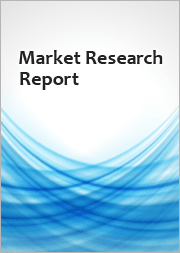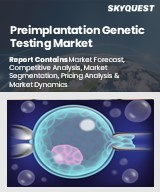
|
시장보고서
상품코드
1650834
유럽의 유전학적 검사 시장 : 유전자 검사 유형별, 국가별 - 분석과 예측(2024-2033년)Europe Hereditary Genetic Testing Market: Focus on Genetic Testing Type and Country - Analysis and Forecast, 2024-2033 |
||||||
유럽의 유전학적 검사 시장 규모는 2024년에 71억 3,000만 달러에 달했습니다.
이 시장은 2034년에는 210억 6,000만 달러에 달할 것으로 예측되며, 예측 기간인 2024-2034년의 CAGR은 12.79%에 달할 것으로 전망되고 있습니다. 유럽 시장은 지속적인 기술 향상으로 인해 빠르게 성장하고 있습니다. 유전자 시퀀싱 기술, 특히 차세대 염기서열 분석(NGS)의 발전으로 유전자 검사는 더욱 정확하고 효율적이며 저렴한 가격으로 제공되고 있습니다. 유전성 질환의 진단 및 치료를 위한 유전자 검사의 이점에 대한 의료 전문가와 일반 대중의 인식이 높아지면서 수요를 견인하고 있습니다. 또한 유전성 질환과 유전성 암 발생률 증가로 인해 조기 진단 및 개인 맞춤형 치료 솔루션의 필요성이 강조되고 있습니다. 산전검사, 신생아 선별검사, 종양학, 정밀의료 등 유전자 검사의 용도가 확대되고 있는 것도 시장 성장을 더욱 촉진하고 있습니다. 유전자 검사의 품질과 신뢰성은 규제 당국의 지원과 조화로운 유럽 가이드라인에 의해 보장되고 있으며, 이는 이 지역 전체에서 시장 확대를 촉진하고 있습니다.
| 주요 시장 통계 | |
|---|---|
| 예측 기간 | 2024-2033년 |
| 2024년 평가 | 71억 3,000만 달러 |
| 2033년 예측 | 210억 6,000만 달러 |
| CAGR | 12.79% |
유럽의 유전학적 유전자 검사 시장은 유전자 염기서열 분석 기술의 발달, 인식 증가, 맞춤형 의료에 대한 니즈 증가로 인해 빠르게 성장하고 있습니다. 유전성 질환의 진단, 유전성 질환 소인의 발견, 희귀 유전성 질환, 낭포성 섬유증, 유전성 암 등의 조기 개입을 촉진하기 위해서는 유전학적 검사가 필수적입니다.
차세대 염기서열 분석(NGS) 기술의 보급으로 유전자 검사의 정확성, 유효성, 경제성이 크게 향상되어 환자와 의료 전문가들이 유전자 검사에 접근할 수 있게 되었습니다. 신생아 검진 및 경력 검사 프로그램을 지원하는 정부 구상과 유리한 규제 프레임워크 및 환급 정책은 시장 확대를 더욱 촉진하고 있습니다.
유전성 질환과 유전성 암의 발병률이 증가함에 따라 종합적인 검사 솔루션에 대한 수요가 증가하고 있습니다. 또한 의사의 처방전 없이도 유전 정보를 얻을 수 있는 소비자 직접 의뢰(DTC) 유전자 검사 서비스의 인기도 높아지고 있습니다. 생식의학 검사, 종양유전학, 맞춤의료에 대한 막대한 투자로 인해 시장의 범위는 더욱 확대되고 있습니다.
유럽이 정밀의료와 질병 조기 발견을 우선시하는 한, 유전학 유전자 검사 시장은 안정적으로 성장할 것으로 예상됩니다. 이러한 성장은 기술 발전, 규제 조화, 일반 대중의 인식 향상에 의해 촉진될 것으로 예상됩니다.
유럽의 유전학적 검사 시장에 대해 조사했으며, 시장의 개요와 유전자 검사 유형별, 국가별 동향 및 시장에 참여하는 기업의 개요 등을 제공하고 있습니다.
목차
개요
제1장 유전학적 검사 : 업계 전망
- 유전학적 검사의 현황
- 시장의 발자국과 향후 가능성
- 동향 : 현재 및 향후 영향 평가
- R&D 리뷰
- 전체 시장 규모와 침투율
- 법적 및 규제상 프레임워크
- 상환 시나리오
- 시장 역학
제2장 지역
- 촉진요인과 억제요인
- 유럽
제3장 시장 - 경쟁 벤치마킹과 기업 개요
- 경쟁 구도
- 주요 전략과 개발
- 기업 점유율 분석
- 기업 개요
- Centogene AG
- Eurofins Scientific SE
- F. Hoffmann-La Roche Ltd
제4장 조사 방법
KSA 25.02.26Introduction to Europe Hereditary Genetic Testing Market
The Europe hereditary genetic testing market was valued at $7.13 billion in 2024 and is anticipated to reach $21.06 billion by 2034, witnessing a CAGR of 12.79% during the forecast period 2024-2034. The market in Europe is expanding rapidly due to continuous technological improvements. Genetic testing is now more accurate, efficient, and affordable thanks to advancements in genetic sequencing technologies, especially next-generation sequencing (NGS). Demand is being driven by growing awareness of the advantages of genetic testing for diagnosing and treating hereditary conditions among healthcare professionals and the public. Additionally, the need for early diagnosis and individualized treatment solutions is highlighted by the rising incidence of genetic disorders and hereditary cancers. The expanding applications of genetic testing, such as prenatal and newborn screening, oncology, and precision medicine, further bolster the market's growth. The quality and dependability of genetic tests are guaranteed by regulatory support and harmonized European guidelines, which promote market expansion throughout the region.
Market Introduction
| KEY MARKET STATISTICS | |
|---|---|
| Forecast Period | 2024 - 2033 |
| 2024 Evaluation | $7.13 Billion |
| 2033 Forecast | $21.06 Billion |
| CAGR | 12.79% |
The market for hereditary genetic testing in Europe is growing quickly due to developments in genetic sequencing technologies, rising awareness, and a growing need for individualized medical care. In order to diagnose inherited disorders, detect genetic disease predispositions, and facilitate early interventions for conditions like rare genetic disorders, cystic fibrosis, and hereditary cancers, hereditary genetic testing is essential.
The accuracy, effectiveness, and affordability of genetic tests have increased dramatically with the widespread use of next-generation sequencing (NGS) technologies, opening up access to them for patients and healthcare professionals alike. Further propelling market expansion are government initiatives supporting newborn screening and carrier testing programs, as well as advantageous regulatory frameworks and reimbursement policies.
The rising incidence of genetic disorders and hereditary cancers is driving demand for comprehensive testing solutions. Additionally growing in popularity are direct-to-consumer (DTC) genetic testing services, which give people access to genetic information without a doctor's prescription. The market's scope is being further expanded by significant investments in reproductive health testing, oncology genetics, and personalized medicine.
The market for hereditary genetic testing is expected to grow steadily as long as Europe prioritizes precision medicine and early disease detection. This growth will be aided by technological advancements, harmonized regulations, and rising public awareness.
Market Segmentation:
Segmentation 1: by Genetic Testing Type
- Oncology Genetic Testing
- Cardiology Genetic Testing
- Neurology Genetic Testing
- Newborn Screening
- Prenatal Screening (NIPT) and Preimplantation Testing
- Rare Disease Testing
- Direct-to-consumer (DTC) Testing
Segmentation 2: by Region
- Europe
- Germany
- U.K.
- France
- Spain
- Netherlands
- Rest-of-Europe
How can this report add value to an organization?
Product/Innovation Strategy: The Europe hereditary genetic testing market has been extensively segmented based on various categories, such as genetic testing type and country. This can help readers get a clear overview of which segments account for the largest share and which ones are well-positioned to grow in the coming years.
Growth/Marketing Strategy: Partnerships, alliances, and collaborations accounted for the maximum number of key developments.
Competitive Strategy: The Europe hereditary genetic testing market has numerous established players with product portfolios. Key players in the Europe hereditary genetic testing market analyzed and profiled in the study involve established players offering products for hereditary genetic testing.
Key Market Players and Competition Synopsis
The companies that are profiled have been selected based on inputs gathered from primary experts and analyzing company coverage, product portfolio, and market penetration.
Some prominent names established in this market are:
- Centogene AG
- Eurofins Scientific SE
- F. Hoffmann-La Roche Ltd
Table of Contents
Executive Summary
Scope and Definition
1 Hereditary Genetic Testing: Industry Outlook
- 1.1 Current State of Hereditary Genetic Testing
- 1.2 Market Footprint and Future Potential
- 1.3 Trends: Current and Future Impact Assessment
- 1.3.1 Increasing Demand for Direct-to-consumer Testing
- 1.3.2 Increasing Launch of Innovative Products and Regulatory Approvals in Genetic Testing Ecosystem
- 1.4 R&D Review
- 1.4.1 Patent Filing Trend (by Year, Country)
- 1.5 Total Addressable Market and Penetration
- 1.6 Legal and Regulatory Framework
- 1.6.1 Europe
- 1.6.1.1 Germany
- 1.6.1.2 France
- 1.6.1.3 Italy
- 1.6.1 Europe
- 1.7 Reimbursement Scenario
- 1.8 Market Dynamics
- 1.8.1 Market Drivers
- 1.8.1.1 Rising Prevalence of Genetic Disorders along with Rare Diseases
- 1.8.1.2 Increasing Inorganic Growth Activities in the Field of Hereditary Genetic Testing
- 1.8.1.3 Increasing Number of Hereditary Genetic Tests
- 1.8.2 Market Restraints
- 1.8.2.1 High Cost Associated with Testing
- 1.8.2.2 Shortage of Genetic Counselors
- 1.8.3 Market Opportunities
- 1.8.3.1 Expansion into Emerging Markets
- 1.8.1 Market Drivers
2 Region
- 2.1 Drivers and Restraints
- 2.2 Europe
- 2.2.1 Regional Overview
- 2.2.2 Driving Factors for Market Growth
- 2.2.3 Factors Challenging the Market
- 2.2.4 France
- 2.2.5 Germany
- 2.2.6 U.K.
- 2.2.7 Spain
- 2.2.8 Netherlands
- 2.2.9 Rest-of-Europe
3 Markets - Competitive Benchmarking & Company Profiles
- 3.1 Competitive Landscape
- 3.1.1 Key Strategies and Development
- 3.1.1.1 Mergers and Acquisitions
- 3.1.1.2 Product Launches
- 3.1.1.3 Synergistic Activities
- 3.1.1.4 Business Expansion Activities and Others
- 3.1.2 Company Share Analysis
- 3.1.1 Key Strategies and Development
- 3.2 Company Profiles
- 3.2.1 Centogene AG
- 3.2.1.1 Overview
- 3.2.1.2 Top Products/Product Portfolio
- 3.2.1.3 Top Competitors
- 3.2.1.4 Key Personnel
- 3.2.1.5 Analyst View
- 3.2.2 Eurofins Scientific SE
- 3.2.2.1 Overview
- 3.2.2.2 Top Products
- 3.2.2.3 Top Competitors
- 3.2.2.4 Key Personnel
- 3.2.2.5 Analyst View
- 3.2.3 F. Hoffmann-La Roche Ltd
- 3.2.3.1 Top Products
- 3.2.3.2 Top Competitors
- 3.2.3.3 Key Personnel
- 3.2.3.4 Analyst View
- 3.2.1 Centogene AG
4 Research Methodology
- 4.1 Data Sources
- 4.1.1 Primary Data Sources
- 4.1.2 Secondary Data Sources
- 4.1.3 Data Triangulation
- 4.2 Market Estimation and Forecast
- 4.3 Criteria for Company Profiling



















